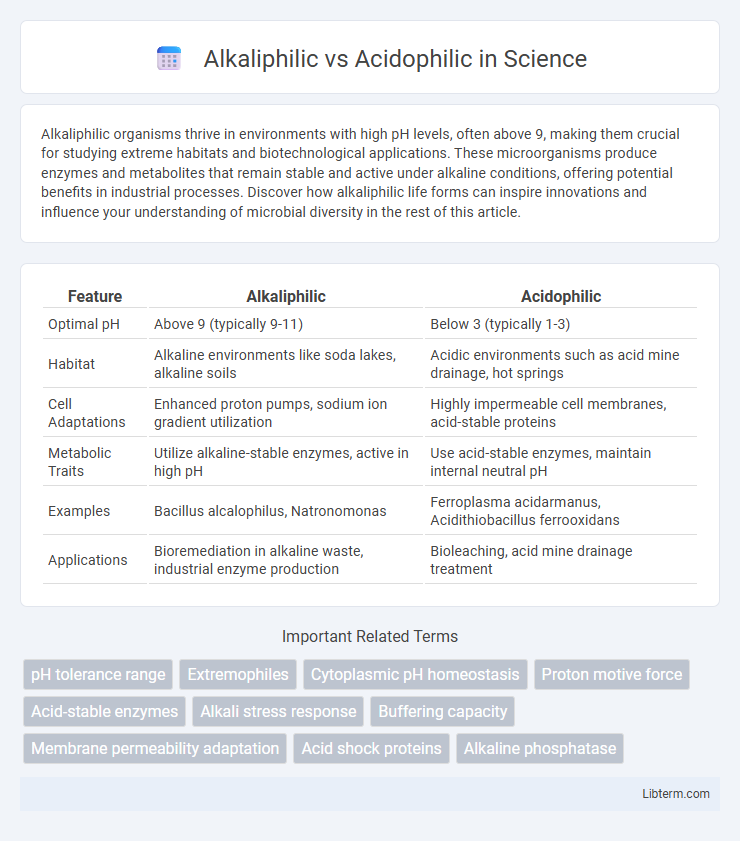Alkaliphilic organisms thrive in environments with high pH levels, often above 9, making them crucial for studying extreme habitats and biotechnological applications. These microorganisms produce enzymes and metabolites that remain stable and active under alkaline conditions, offering potential benefits in industrial processes. Discover how alkaliphilic life forms can inspire innovations and influence your understanding of microbial diversity in the rest of this article.
Table of Comparison
| Feature | Alkaliphilic | Acidophilic |
|---|---|---|
| Optimal pH | Above 9 (typically 9-11) | Below 3 (typically 1-3) |
| Habitat | Alkaline environments like soda lakes, alkaline soils | Acidic environments such as acid mine drainage, hot springs |
| Cell Adaptations | Enhanced proton pumps, sodium ion gradient utilization | Highly impermeable cell membranes, acid-stable proteins |
| Metabolic Traits | Utilize alkaline-stable enzymes, active in high pH | Use acid-stable enzymes, maintain internal neutral pH |
| Examples | Bacillus alcalophilus, Natronomonas | Ferroplasma acidarmanus, Acidithiobacillus ferrooxidans |
| Applications | Bioremediation in alkaline waste, industrial enzyme production | Bioleaching, acid mine drainage treatment |
Introduction to Extremophiles
Extremophiles are microorganisms adapted to thrive in extreme environments, with alkaliphilic and acidophilic types specializing in high pH and low pH habitats, respectively. Alkaliphilic extremophiles flourish in environments with pH levels typically above 9, such as soda lakes and alkaline soils, employing cellular mechanisms to maintain pH homeostasis. Acidophilic extremophiles inhabit acidic environments with pH levels often below 3, like acid mine drainages and sulfur springs, using specialized adaptations to protect cellular components from acid damage.
Defining Alkaliphilic and Acidophilic Organisms
Alkaliphilic organisms thrive in environments with pH levels typically above 9, exhibiting adaptations that enable survival in highly alkaline conditions such as soda lakes and alkaline soils. Acidophilic organisms prefer acidic environments with pH levels below 5, commonly found in acidic mine drainage, sulfur springs, and acid sulfate soils. Both groups possess unique cellular mechanisms to maintain homeostasis and function optimally under extreme pH conditions.
Environmental Conditions: Alkaline vs Acidic Habitats
Alkaliphilic organisms thrive in environments with a pH typically above 9, such as soda lakes and alkaline soils, where they have adapted mechanisms to maintain cellular homeostasis under high pH conditions. Acidophilic microorganisms prefer acidic habitats with a pH below 3, commonly found in acidic hot springs, sulfuric pools, and acid mine drainage sites, where they resist proton influx to survive. These contrasting adaptations allow alkaliphiles and acidophiles to colonize extreme pH niches, driving biogeochemical cycles in their respective alkaline or acidic ecosystems.
Key Adaptations in Alkaliphiles
Alkaliphilic microorganisms thrive in environments with pH levels above 9 by employing specialized sodium-dependent bioenergetic pathways that maintain intracellular pH homeostasis. Their cell membranes contain unique lipids and an increased expression of sodium/proton antiporters that actively export excess hydroxide ions to prevent cytoplasmic alkalinization. Additionally, alkaliphiles possess enzymes with optimal activity at high pH, enabling efficient metabolic processes in extreme alkaline conditions.
Unique Features of Acidophiles
Acidophiles thrive in extremely low pH environments, often below pH 3, by maintaining internal pH homeostasis through proton pumps and highly impermeable cell membranes to prevent acid infiltration. Their proteins and enzymes exhibit extraordinary acid stability and functionality, enabling metabolic processes in harsh acidic conditions. These adaptations distinguish acidophiles from alkaliphiles, which are specialized for high pH environments above pH 9.
Metabolic Strategies and Energy Production
Alkaliphilic microorganisms thrive in high pH environments by utilizing specialized sodium ion gradients and unique membrane-bound enzymes to drive ATP synthesis, optimizing energy production under alkaline conditions. Acidophilic organisms, conversely, maintain internal pH homeostasis through proton pumps and acid-stable enzymes, enabling efficient metabolic processes in highly acidic habitats. Both groups exhibit distinct adaptations in their electron transport chains and ion transport mechanisms, reflecting their divergent metabolic strategies tailored to extreme pH environments.
Biotechnological Applications of Alkaliphiles
Alkaliphilic microorganisms thrive in high pH environments above 9, producing enzymes like alkaline proteases and cellulases that are widely used in detergents, textile processing, and bioremediation. These microbes facilitate industrial processes by degrading organic waste, enhancing pulp bleaching, and enabling bioconversion under alkaline conditions, where acidophiles cannot survive. The unique metabolic capabilities and extremozymes of alkaliphiles make them invaluable for sustainable biotechnology and eco-friendly applications.
Industrial Uses of Acidophilic Microbes
Acidophilic microbes thrive in highly acidic environments, making them essential for bioleaching processes in mining industries to extract metals like copper and gold. Their ability to oxidize sulfide minerals enhances metal recovery while reducing environmental impact compared to traditional methods. These microbes also play a crucial role in waste treatment by breaking down acidic effluents, contributing to sustainable industrial practices.
Challenges in Cultivating Extremophiles
Cultivating alkaliphilic and acidophilic extremophiles presents challenges due to their requirement for extreme pH conditions, with alkaliphiles thriving above pH 9 and acidophiles below pH 3. Maintaining stable pH environments in laboratory settings demands precise buffering systems and specialized bioreactors to prevent contamination and ensure cellular viability. These extremophiles often exhibit slow growth rates and unique membrane adaptations, complicating nutrient uptake and metabolic activity under artificial cultivation conditions.
Future Directions in Extremophile Research
Future directions in extremophile research emphasize genetic and metabolic pathway analysis to harness the unique adaptations of alkaliphilic and acidophilic microorganisms for biotechnological innovations. Advances in metagenomics and synthetic biology enable the design of customized enzymes and bio-catalysts capable of thriving in extreme pH environments. Exploration of these extremophiles promises breakthroughs in industrial applications, environmental bioremediation, and novel pharmaceutical compounds.
Alkaliphilic Infographic

 libterm.com
libterm.com